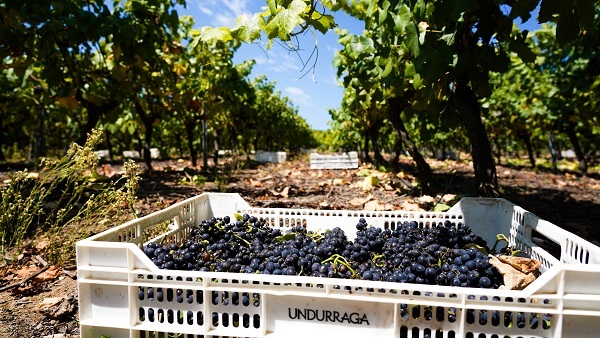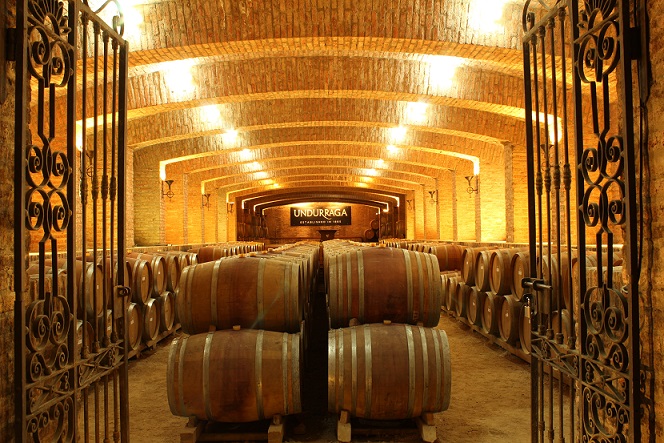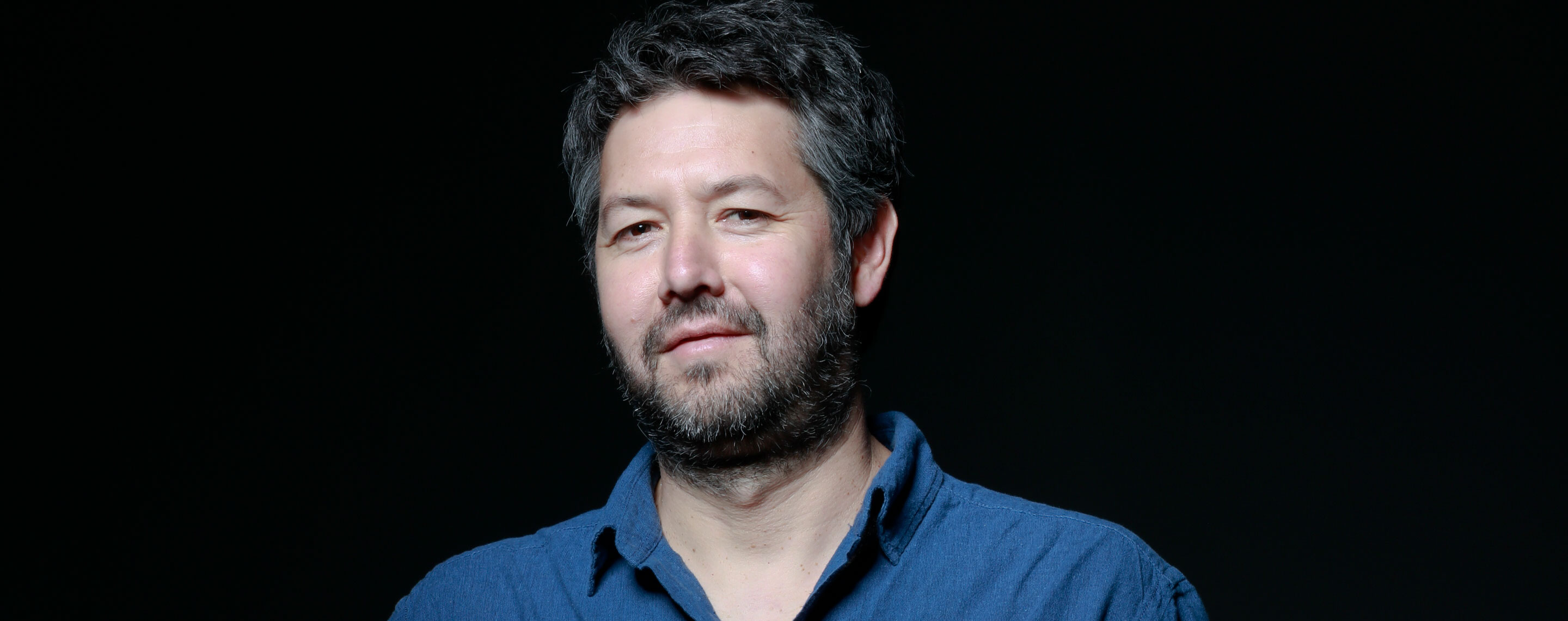Rafael Urrejola, chief winemaker at Viña Undurraga, was named Red Winemaker of the Year. It’s the first time a Chilean winemaker has won this prestigious title.
It’s thoroughly deserved as Rafael was awarded three trophies, four gold medals and four silvers in this year’s IWC, the world’s most rigorously judged and impartial blind tasting. He won the Chilean Cabernet Sauvignon Trophy with the T.H. Cabernet Sauvignon Alto Maipo 2021, the Chilean Pinot Noir Trophy with the Trama Pinot Noir 2021, and Chilean Carignan Trophy with the T.H. Carignan Maule 2021. This wine, which the IWC judges described as “fabulously fruity with plums, bramble fruit, forest and mulberries”, also took the Chilean Red Trophy.
Canopy: It seems impressive to win trophies for Cabernet Sauvignon and Pinot Noir and the Chilean Red Trophy for Carignan in the same competition. How have you adapted your winemaking to get the best out of these very different grape varieties?
Rafael: “They are all quite different to make and to approach. I think what could be common in these wines is the way we’ve been understanding the vineyard and the character we can get out of each origin, together with the quality potential.
“This search for identity and freshness in the wines, with no makeup or significant intervention, I think it fits well to the judges and also to the taste of UK consumers.”
Two of them are part of the Terroir Hunter (T.H.) series – have you found the right terroir for each grape variety?
Rafael: “I think so. Cabernet Sauvignon in Maipo Valley and specially in Pirque – the coolest and highest spot in Maipo – and with an old vine vineyard, makes it an extraordinary terroir for the style of wines I want to make. And the 70-year-old ungrafted vines of Carignan in the dry farm area of Maule are just unbeatable for an expressive, intense and superb Carginan.”
What have you discovered about what thrives where?
Rafael: “I’ve discovered for myself that the cooler it gets – as long you can ripen a variety properly – the best, most interesting character you will get in the wines. Where maybe only Carignan could be an exception.”
Why is that?
Rafael: “What I’ve seen in Chile, with our soil and climate conditions, is that most of the grape varieties are affected by hot and hot-dry seasons. I have seen much better balance in aromas, flavours and tannin structure in moderate and cooler vintages. Lower pH, brighter acidity, lower alcohol levels and ripe and rounded tannins if you pick at the right time.
“In hotter seasons, it’s harder to keep that balance in most of the varieties, and most of the times you need to choose between alcohol/acidity balance and tannin ripeness. Those are hard vintages to work with. Anyhow, it’s perfectly possible to end up with great wines, but they need more work and attention.
“However, the Carignan in Cauquenes area in Maule, with dry-farming and old vines, performs really well in moderate and cool years, but also in hot seasons.
“For the style on T.H. wines, I prefer the expression it gets in cooler years, like this 2021, when it shows more of the forest-wild berries expression and floral notes, and balanced refreshing long palate. Although, in warmer years like 2020 or 2017, the natural strength of Carignan vines and berries to the heat have brought us also fine and good wines in these vintages, being maybe an exception with other varieties that seem to be more affected by the heat.”

How important is handpicking?
Rafael: “For me, it is still very important, in the high-end wines, because it gives you the chance to select clusters and grapes. Machine harvest has been improving a lot in terms of quality and for a great amount of wines it works very well. But for our Terroir Hunter series I think is still much better the handpicking.”
How do you sort the grapes in the winery?
Rafael: “All T.H. series grapes are handpicked in small 12kg cases. Then we dump the grapes on a sorting table, where we take out all the unripe, rot, or out-of-type clusters, together with any leaves or green elements that could be in the cases. Then, after the destemmer, we also select and take out any stem pieces that could have fallen with the grapes, and any unripe or green berries.”

Are they all fermented in stainless-steel tanks so you can control the fermentation temperatures and extraction?
Rafael: “Yes, all in stainless steel. Different sizes and dimensions, but all small, under 12-ton per tank. Temperature control is possible, so they ferment between 22 and 28°C, so moderate temperature.”
What are the key winemaking methods used for your red wines?
Rafael: “I think the key for all of these varieties is to understand and respect the genuine expression of the terroir. Harvest point or date is very relevant to start with the best quality potential. Then the style I’ve been making wines in my whole career is to moderate the extraction in order to have a better balance in the wine.”
“Pinot Noir must be fermented in open tanks and very carefully in terms of temperatures and extraction. Short and gentle punchdowns to extract only the best out of the skins. And then not a very long period of maceration with skins – 14 to 18 days at the most.
“With Carignan we have learned also to treat it very delicately, just a little more extraction than Pinot Noir. And then a moderate time with skins – 20 to 30 days.
“Cabernet can hold a longer period with the skins and a bit more extraction, but always being careful to extract good and ripe tannins.”

So you favour delicate reds over big reds – why’s that?
Rafael: “Yes, I always have. When I had the chance from the market to make big reds, I was making delicate Pinot Noir in Leyda. Then I fell in love with the idea of making fresher, delicate, vertical reds from other varieties. Fortunately, the mood for big reds went out, and I was successful with this style of wines, which I’d always liked to make and to drink.”
‘I fell in love with the idea of making fresher, delicate, vertical reds from other varieties’Why do you use a concrete egg for ageing the Pinot Noir, small barrels for the Cabernet Sauvignon and a large foudre for the Carignan?
Rafael: “We’ve learned over these years where we get better results during the ageing. Wines are different and they all need a different kind of space and oxygen transfer dynamics.
“Concrete keeps our Pinot Noir tight and fresh, keeping the minerality untouched and vibrant. We can soften the tannins with the action of the lees – which the egg shape of the tank permits, so they are all the time in suspension and in contact with the wine.
“Cabernet Sauvignon ages great in 225L barrels, probably that’s the reason Bordeaux developed these barrels after centuries of experience. They give the right amount of oxygen and tannin structure the Cabernet can hold, enhancing its structure and flavours.
“Carignan is quite versatile in terms of ageing. I prefer the vertical, linear style we obtain in foudres, compared to the richness we could get from barrels. It seems that the wine expresses itself better in these large casks, softening up the tannins, keeping the freshness and the tension in the wine.”
These three wines are all from the 2021 vintage – did you do anything different in 2022 or 2023?
Rafael: “2021 was an extraordinary vintage in Chile and in such different areas as Leyda, Maipo and Maule. It was an even and cool year, so we could make a right and scheduled harvest, ripening the skins without losing freshness or too high sugar levels. This vintage gave us very balanced wines.
“Every year is different so, even though we try to keep the style and the decisions the same year by year, we need to understand each vintage differently and try to get the most out of them.
“2022 was similar to 2021, slightly warmer but still a fresh one. 2023 was a hot year, so we picked everything earlier than usual. That determines different kind of raw material to start with, so there are some different decisions at the cellar too.”
What sort of decisions?
Rafael: “In our case, in warmer years, we try to prioritise the flavours together with the acidity and sugar levels. Thus, sometimes the ripeness of the tannins is not even with the other variables. Normally we get sugar and acid at good levels before the tannins are totally ripe, in warm years.
“So we manage the extraction differently during fermentation, trying to extract less tannins but better ones. That means lower temperatures than normal during fermentation peaks (below 26°C, compared to regular 28-29°C, for example), softer regime of pumpovers (shorter in time and fewer per 24 hours).
“And then shorter skin maceration after fermentation (10 to 15 days compared to 20-25 days as regular).
“All of these tools give us the chance to keep the style of the expression we want to obtain. Freshness, typicity and sense of place. And not the usual (not necessarily in a negative way, though) rich, dense and tannic wine that we could obtain from a warm/dry season.”

 English
English French
French







.png)


